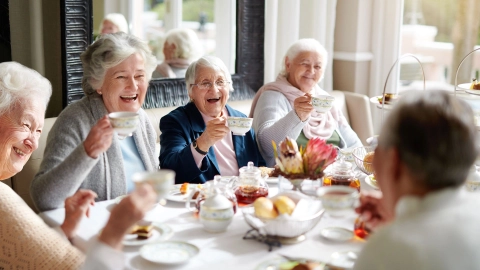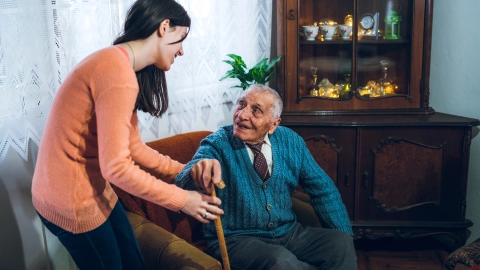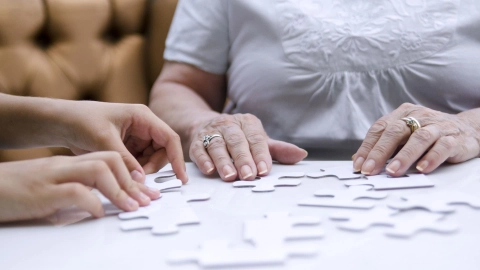Care Accessible living: information on renovations and aids
Accessible homes enable people to remain within their own four walls for as long as possible regardless of age, care needs or disability. But what does “accessible” actually mean? How can the necessary renovations, aids and adaptations be financed and organized?
At a glance
- Even small obstacles can pose major accessibility issues for people who are elderly, disabled or in need of care.
- An accessible home enables people to live largely independently and remain within their own four walls for as long as possible.
- Numerous aids can make everyday life easier.
- Minor adaptations can be helpful and quickly implemented. Major renovations must be carefully planned.
- There are several ways to obtain grants and loans for accessibility renovations.
- Advice should be sought on the individual options. This can also be provided during home visits.

Why are accessible homes important?
Steps, baths, raised thresholds, carpets, dark corridors – many large and even small obstacles can make everyday life in their own home more difficult for people in need of care or with physical disabilities, and cause accidents. Accessible apartments and houses, on the other hand, make everyday activities in the home easier and safer, and are particularly important for enabling people to lead a self-determined life that is as independent as possible.
Most people want to live in the comfort of their own home for as long as possible. Renovating the home and adapting it to needs as well as using special aids can make this possible while also making it easier for relatives or care services to provide care.
An accessible surrounding environment is just as important as a suitable home: good connections to local public transport, nearby shops and health care services plus a supportive network locally promote independent living.
What does accessible living mean?
Homes are classed as accessible if people with disabilities or care needs are able to live in them without any particular difficulties or help from others.
The standards for accessible living for people with different disabilities and care needs are defined in a DIN standard.
Homes are classed as accessible if
- they are on ground level and can be accessed without steps or raised thresholds. It must also be possible to reach control features such as window handles, cupboards and light switches in this manner.
- doorways are of a certain width
- the bathroom, hall and kitchen are sufficiently large to move around freely and also offer enough room for a carer
- the bathroom is furnished safely: a walk-in shower, walk-in bath and wheelchair accessible sink are the most important requirements.
- non-slip flooring has been laid that does not dazzle or blind
The technical requirements for accessibility are established in DIN construction standard 18040-2. This considers motor, sensory and mental disabilities, for example blindness, impaired vision and hearing, and disorientation. DIN construction standard 18040 is currently being revised and adapted to European regulations.
DIN construction standard 18040-2 for accessible homes can be found on the website of the Association for Accessible Living (Verein Barrierefrei Leben e.V.).
In addition to “accessible”, terms like partially accessible, disabled friendly, elderly friendly, age appropriate and wheelchair accessible are commonly used. These are often used interchangeably but are unclear and not legally defined.
Partially accessible usually means that some areas of the home are not accessible and that help is still required during everyday life. Disabled friendly does not automatically mean that the house or apartment is also suitable for people with a visual or mental disability.
When looking for a place to live, it is advisable to check out the premises in person. For example, even accessible apartments can sometimes have a front door that can only be accessed via a couple of steps or lifts can be too small.
Accessible living: what aids are available?
Renovation isn’t always necessary. There are also many small aids that can make everyday living at home easier and safer.
For example:
- a second hand rail on the stairs
- motion sensors for automatic lighting
- grip aids
- handholds
- window handle extensions that make it easier to open and close windows that are hard to reach
The cost of some aids can be reimbursed by health and care insurance providers. In the case of several aids, such as motion sensors or plug-in night lights, low-cost alternatives can be purchased from DIY stores.
The Verein Barrierefrei Leben e.V. provides an overview of aids for various areas of life (in German only).
Accessibility: What home adaptation options are available?
Home renovations and adaptations enable people to move around safely and independently within their own four walls and to perform everyday activities as easily as possible. It is particularly important that the homes that people with dementia are used to are safely and clearly designed.
To determine which home adaptations are important for you, run through your daily routine in your mind. Note down where you typically encounter problems and obstacles or depend on other people’s help. You can then use this list to gradually make appropriate adaptations.
The “Aging at home” service portal from the Federal Ministry for Family Affairs provides a checklist that can be used to assess whether homes are age appropriate.
Minor measures
Many useful changes can be implemented yourself or with a little help from family, friends or neighbors:
- Repositioning or removing furniture is an easy way of creating more space to move around. Furnishings, windows and switches should also be easily accessible.
- The room layout can be rearranged and, for example, the bedroom moved to another room if this creates enough space to move around between the bed, cupboards and windows. In multi-level houses, the main rooms used could be moved onto the ground floor.
- Important, frequently used items, such as keys, telephones or cutlery, can be accessed safely and easily if stored within reach.
- Carpets and runners should be removed or carefully secured plus any cables that are lying around should be properly routed to eliminate trip hazards.
- Bright, low-reflection lighting without shadows also helps to prevent falls. Furthermore, a high-contrast interior helps people with impaired vision orientate themselves.
- Sofas, armchairs or beds can be raised using special leg extensions to make it easier to stand up and sit down.
Major renovations
Depending on the specific needs, major structural measures may also be necessary, for example if you are no longer able to cope with stairs or use the bathroom and kitchen independently.
In many cases,
- worktops and washbasins that a wheelchair or wheeled walker can fit under are installed
- doorways are widened
- raised door thresholds are removed or small ramps are installed
- special control features and handles are installed
- walk-in baths or showers are installed
- circulation areas are enlarged. In some situations, it is also possible to change the layout of the home or to switch rooms such as the kitchen and bathroom.
Renovations generally have to be completed by a professional and need more time to plan and finance. Professional advice is particularly important in relation to major structural work. An on-site check of which measures are useful, possible and necessary for your personal situation should always be performed as this depends on the individual environment. Advice centers often offer free home visits.
What technology is useful for accessible living?
Technical products help people live in their own home in a self-determined, independent manner. They can also help prevent accidents and injuries.
Examples of technology include:
- automatic stove shut-off devices and water sensors
- stair lifts, elevators and other electrical repositioning and transfer aids
- home emergency call systems (with sensors)
- fall prevention sensor mats that alert carers so that they can prevent a fall or quickly assist someone who has fallen
- digital care aids such as automatic tablet dispensers
The latest digital technologies and assistance systems offer further opportunities for independent living. These partially intelligent and self-learning systems can assist residents with everyday activities, monitor their health and, thanks to their algorithms, adapt ever better to residents’ habits. However, their use also raises ethical and legal questions.
Technical systems for the home are often summarized by the term “ambient assisted living” (AAL).
The consumer advice center (Verbraucherzentrale) website offers information about how digital assistance systems can support age-appropriate living.
Example: How can I make my bathroom accessible?
Major renovations, such as making a bathroom accessible, usually have to be performed by a professional.
The following apply with regard to accessible bathrooms:
- They should be large enough to be able to move around in a wheelchair and with walking aids plus offer enough room for a carer to provide a helping hand.
- Walk-in showers are the safest option for elderly people and people in need of care as there is no risk of tripping when accessing them.
- It can sometimes make sense to remove the bath to create space for a larger shower that a shower chair can fit in or to make more room to move around the bathroom.
- Those who want to keep a bath can install a walk-in version, although such baths are not classed as accessible.
- The sink or wash basin should be wheelchair accessible.
- The flooring should be non-slip.
It is sometimes a good idea to switch rooms around, for example by moving the bathroom to another room.
Bathroom aids
Aids make it possible to use the toilet, shower or bath largely independently:
- A shower chair or wall-mounted folding seat allows users to shower while sitting down.
- Handholds make it easier to stand up or move around the bathroom.
- Non-slip rubber mats reduce the risk of falling in the shower and bath.
- Toilet seat elevators make it easier to sit down and stand up.
How can I finance an accessibility renovation?
In particular, complex and major structural measures such as installing stair lifts, creating accessible bathrooms or widening doorways can be extremely expensive. There are various grants and funding options for financing accessibility renovations.
The available finance options often depend on people’s personal situation and why the home is being renovated. It is therefore wise to seek advice about finance options in advance.
The costs of accessible renovations can, for example, be covered by:
- long-term care insurance providers
- health insurance providers
- rehabilitation funding organizations
- the KfW program “Age-appropriate construction” (“Altersgerechtes Bauen”)
- state and municipality funding programs
Long-term care insurance providers
People with a care grade (1 to 5) can apply to a long-term care insurance provider for a grant for “home improvement measures”. Grants of up to 4,180 euros per measure can be awarded if the renovations make at-home care or independent living easier or possible.
If several people with an assigned care grade live together, as in an outpatient group home for example, long-term care insurance providers will award a grant of up to 16,720 euros. Start-up financing is available for newly established, supported outpatient group homes. To renovate homes for such use, long-term care insurance providers will pay 2,613 euros per person and up to 10,452 euros per group home.
Health insurance providers
Health insurance providers finance certain aids that make independent living easier or possible – but only if they have been prescribed by a doctor.
The assumption of costs by the health insurance provider must be applied for by submitting an ordinance on assistive technology (Hilfsmittelverordnung) from a doctor. If the health insurance provider approves the costs, statutory insurance holders must make an additional payment of a maximum of 10 euros.
Health insurance providers have generally entered into framework agreements with certain manufacturers, meaning that only certain products can be used. Large aids such as care beds are usually leased by long-term health insurance providers.
Rehabilitation funding organizations
The term “rehabilitation funding organization” (“Reha-Träger”) is used to refer to various institutions that cover the cost of social, medicinal and professional rehabilitation (rehabilitation). These should enable people who have or are at risk of a disability to participate in society. The cost of accessibility renovations to a home can also be covered.
Rehabilitation funding organizations include statutory health insurance and pension insurance providers but also child and adolescent welfare associations. The responsible organization depends on the personal situation, how the disability or illness came about and why the home is being renovated.
The German Employers’ Liability Insurance Associations (“Berufsgenossenschaften”) or accident insurance funds (“Unfallkassen”) may, for example, cover costs if a disability has been caused by an occupational accident and accessible access to the home is required to get to the workplace.
The advisory services from the Supplementary Independent Participation Advice Center (Ergänzende unabhängige Teilhabeberatung – EUTB) offer free information and advice about rehabilitation and participation services.
The KfW program “Age-appropriate construction” (“Altersgerechtes Bauen”)
The federal government funds age-appropriate construction and the purchase of apartments and houses that have been adapted for the elderly via the bank KfW. This can occur by means of a low-interest loan, for example.
Full information about the KfW program can be found on the KfW website. This also provides information about which loans and grants are currently available.
Funding from states and municipalities
Some cities, municipalities and states have their own funding programs for age-appropriate and accessibility renovations and extensions. For further information, please contact the local housing authorities or your state officials for the elderly and disabled.
Renovation costs can also be declared as “extraordinary expenses” on tax returns.
The National Association for Home Renovation (Bundesarbeitsgemeinschaft Wohnungsanpassung e.V.) provides a list of all providers who subsidize and fund accessibility renovations.
What legal considerations are required in relation to accessibility renovations?
Tenants are generally entitled to perform structural accessibility measures if these enable independent living with disabilities or care needs. They usually have to bear the costs of the measures themselves.
Tenants are obliged to consult with the house or apartment owner prior to starting the renovations. There are some measures that owners are under obligation to perform. They may also voluntarily conduct renovations at their own cost. This may result in a rent increase.
On moving out, the tenant is obliged to reverse the accessibility renovations. The owner may therefore require a deposit in advance corresponding to the cost of such reversal.
Joint ownership
Disabled home owners are entitled to perform structural measures to a joint ownership property that enable accessible access to their own home. The co-owners must agree to the measures.
Who provides advice on accessibility renovations?
It is advisable to obtain comprehensive advice prior to any renovations. Residential consultants or advice centers for home adaptations and technical aids provide information about
- how you can renovate your home in line with your needs
- what aids can be used
- how renovations and aids can be financed and which grants are available
They will also
- assist with applications and the clarification of possible legal claims
- provide information on ethical and legal aspects
- review cost estimates
- assist with problems with landlords or cost providers
- recommend suitable building firms
Home visits are generally also possible.
The National Association for Home Renovation website provides a list of independent advice centers for home renovations.
The brochure “Living at home for longer. Guidance for elderly living” (“Länger zuhause leben. Ein Wegweiser für das Wohnen im Alter”) from the Federal Ministry for Family Affairs provides comprehensive information about accessible living.
The consumer advice center’s website offers information and recommendations about many aspects of accessible living, for example on home renovations and individual aids such as stair lifts and home emergency call systems.
- Aktion Mensch. Barrierefrei Bauen. Aufgerufen am 20.12.2024.
- Bundesamt für Justiz. Gesetz über das Wohnungseigentum und das Dauerwohnrecht (Wohnungseigentumsgesetz - WEG)
§ 20 Bauliche Veränderungen. Aufgerufen am 13.12.2024. - Bundesamt für Justiz. Gesetz zur Gleichstellung von Menschen mit Behinderungen (Behindertengleichstellungsgesetz - BGG) § 4 Barrierefreiheit
WEG) § 20 Bauliche Veränderungen. Aufgerufen am 13.12.2024. - Bundesarbeitsgemeinschaft Wohnungsanpassung e.V. Hilfreiche Technik. Aufgerufen am 13.12.2024.
- Bundesarbeitsgemeinschaft Wohnungsanpassung e.V. Wohnungsanpassung. Aufgerufen am 25.11.2021.
- Bundesarbeitsgemeinschaft Wohnungsanpassung e.V. Wohnberatung. Aufgerufen am 13.12.2024.
- Bundesarbeitsgemeinschaft Wohnungsanpassung e.V. Finanzierung von Wohnungsanpassungsmaßnahmen. Aufgerufen am 13.12.2024.
- Bundesministerium für Arbeit und Soziales. Mietrecht. Aufgerufen am 20.12.2024.
- Bundesministerium für Familie, Senioren, Frauen und Jugend. Länger zuhause leben. Ein Wegweiser für das Wohnen im Alter. Artikelnummer: 3BR53 Stand: November 2019, 10. Auflage.
- Bundesministerium für Familie, Senioren, Frauen und Jugend. Standfest im Badezimmer. Aufgerufen am 20.12.2024.
- Bundesministerium für Familie, Senioren, Frauen und Jugend. Kleine Maßnahmen schnell und einfach umsetzen. Aufgerufen am 20.12.2024.
- Bundesministerium für Familie, Senioren, Frauen und Jugend. Worauf kommt es bei der Gestaltung einer altersgerechten Wohnung an? Aufgerufen am 20.12.2024.
- Bundesministerium für Verkehr, Bau und Stadtentwicklung. Altersgerecht umbauen – Mehr Lebensqualität durch weniger Barrieren. Stand vom Juli 2013.
Reviewed by the Hesse consumer advice center Verbraucherzentrale Hessen e.V. (VZH).
As at:





